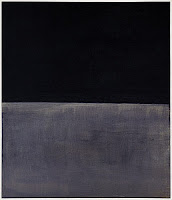Color
is immensely important in not only art, but also in the society. Color visually
defines something, distinguishing between different hues and shades of objects.
For example, the sky can be a light blue while the clouds can either be white
or different shades of gray. Sand is light brown and the ocean is a darker
shade of blue. The variety of colors that we view around the world is large and
each unique. Color is also defined differently depending on the person.
Two individuals can view the same color and feel that they viewed two separate
colors. The determination of the color viewed is in the eye of the beholder.
Color also evokes emotion, which is a characteristic emphasized in art but
unnoticed in daily life interactions. Color sets a tone or specific mood.
For example, the color red evokes anger in some people. The color blue can
evoke either calmness or gloominess in a person. Mark Rothko's art pieces
Number 22 and Black on Grey emphasized how colors can evoke emotion. In Number
22, the colors suggest happiness and calmness. Black on Grey suggests
emptiness, sadness, or even death. Colors are extremely important for setting
the mood of art. Color is also culturally defined. One culture may use a color
in a certain way, while other cultures may use it in a different way. In the
United States, it is common to wear black to funerals and white to weddings. In
China, it is common to wear white to funerals and red to weddings. The meaning
behind a color is highly dependent upon the culture and how it impacts their
values and beliefs. Despite the many meanings a color may have, it should be recognized
and accepted that the world is a canvas, and the color is the paint that brings
it alive.




No comments:
Post a Comment